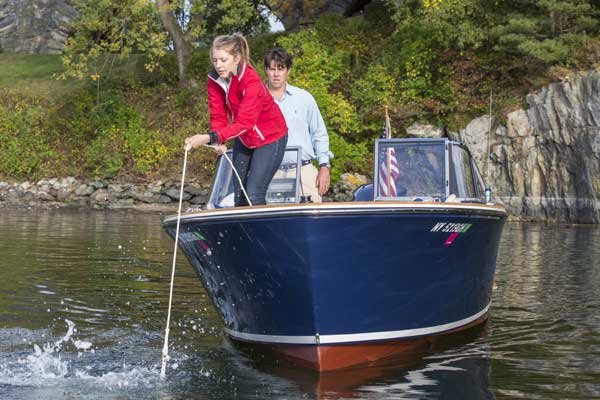
Small Boat Anchoring
Five simple step to follow for reliable anchor sets on small boats.
Here's a short piece from Tim Murphy, BoatUS
Many boaters — whether fishing, swimming, or socializing aboard — spend their best hours anchored rather than underway. With that in mind, let's look at ways to keep your time at anchor comfortable and safe.
- Find A Good Spot
A good anchorage offers protection from wind and waves, swinging room, and a quality bottom. Choosing an anchorage that's protected from waves is the best insurance against dragging, as the loads from a pitching bow increase the likelihood of dragging an anchor. Consider the radius of your anchor rode, plus boat length, when you calculate your swinging circle, allowing for changes in wind or current direction, and water depth due to tides. Make sure there are no boats, shoals, rocks, or other objects in that circle. Finally, make sure your anchor works for the particular bottom; the lightweight fluke-style anchor shown here works best in sand or mud; it wouldn't work well on a grassy, rocky, or hard-clay bottom.
- Prepare For Anchoring
Before the anchor goes over the bow, make sure you have plenty of rode and that it's free of tangles and ready to run. Anchor rode where length is marked ahead of time helps you determine how much to put out. A length of chain helps weigh the rode down at the anchor for better holding. When you're ready to set, the boat should be motionless, or drifting very slowly astern. Any forward motion will knock the anchor against the boat's stem. This is especially true on boats with a plumb (vertical) bow.
- Drop The Hook
Pick a spot to drop anchor, keeping in mind where you want the boat to end up and that the anchor will drag a short distance before it sets. As the boat drifts back, lower the anchor slowly to the bottom, then gently pay out the rode. This will prevent the chain from piling up in a heap. If the anchor and rode all pay out in one line, free of tangles, everything should be ready to set it securely in the bottom. Take a turn around a cleat and snub it off every now and then to let the tackle straighten out.
4. Pay Out The Proper Scope
Here's a great way to figure how much anchor rode you are putting out. Most adult arm spans are between five and six feet across, so you can quickly pay out a 5:1 scope by counting the same number of arm spans of anchor rode as the water depth plus your bow height.
Your anchor holds best when the load on it is horizontal, not vertical, so you'll have to let out enough scope to accomplish that. First, add the depth of the water to the height of the bow above the waterline. Now, multiply that total by 5 (for a 5-to-1 scope), and pay out that amount of rode for a "lunch hook" when you'll be aboard in calm conditions. If it's windy, or you might go ashore for a bit, pay out at least a 7-to-1 scope.
If you're anchoring in water 10 feet deep and your bow is 5 feet above the waterline, water depth + bow height = 15 feet, which means that for a lunch hook you should put out 75 feet of rode (15 feet x 5).
For an overnight stop, put out 105 feet (15 feet x 7). When you calculate scope, don't include the chain at the anchor end of the rode unless there's more than 6 feet or so; the chain's job is simply to weigh down the anchor.
- Set The Hook
Once you've let out ample scope, let the boat settle back on the anchor to straighten out the rode. A gentle breeze or a mild current may be sufficient for this step. If it's absolutely still, use the engine with just a touch of reverse. Pause and take a good look around, especially abeam; note your position relative to other fixed objects.
Now put the engine in SLOW reverse. You can expect to move slightly astern as the anchor and rode set themselves and stretch out. Soon, though, the boat should settle in a fixed position. (If at this stage the boat is still moving astern, your anchor may be dragging; pick it up and drop it again.) If the boat's position is fixed, you should see prop wash near the stern, and your anchor rode should be straight and taut.
To thoroughly set the anchor, with the engine still in reverse, increase the rpm. If the boat stays put, you can rest (relatively) easy, knowing you're hooked. Check your swinging room again, assuming that the wind or current might come from any direction. Have some fun.
When it comes time to move on, you'll need to apply a vertical load to your anchor rode to break the anchor free. This means moving gently forward with the engine, and if you don't have a windlass, gathering aboard as much rode as you can by hand.
Beware to keep the rode out of the propeller and rudder, and communicate the position of the rode with the person on the helm if visibility is blocked. Once the rode is directly below the bow of the boat, take a turn on a cleat. Then, signal the helms person to put the engine in SLOW forward. The anchor should break free; if it doesn't, apply a little more throttle.
Once the anchor is free, go back into neutral. Bring the anchor and rode aboard, taking care not to damage the hull, and rinse off any mud. Coil and stow the rode, and you're ready for your next anchorage.